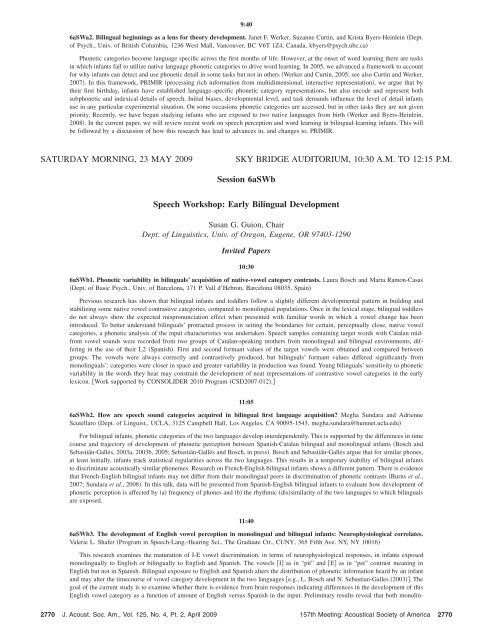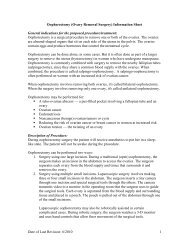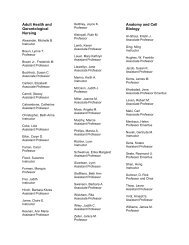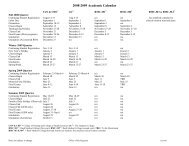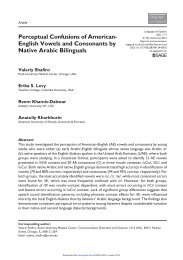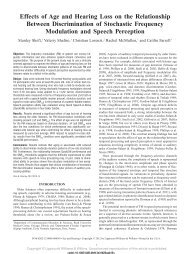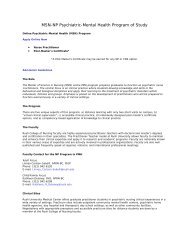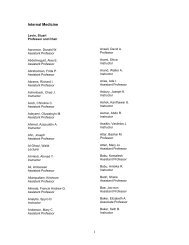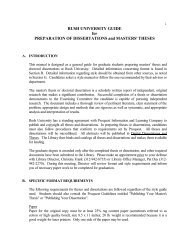Perceptual confusions of American English vowels ... - Rush University
Perceptual confusions of American English vowels ... - Rush University
Perceptual confusions of American English vowels ... - Rush University
You also want an ePaper? Increase the reach of your titles
YUMPU automatically turns print PDFs into web optimized ePapers that Google loves.
9:40<br />
6aSWa2. Bilingual beginnings as a lens for theory development. Janet F. Werker, Suzanne Curtin, and Krista Byers-Heinlein Dept.<br />
<strong>of</strong> Psych., Univ. <strong>of</strong> British Columbia, 1236 West Mall, Vancouver, BC V6T 1Z4, Canada, kbyers@psych.ubc.ca<br />
Phonetic categories become language specific across the first months <strong>of</strong> life. However, at the onset <strong>of</strong> word learning there are tasks<br />
in which infants fail to utilize native language phonetic categories to drive word learning. In 2005, we advanced a framework to account<br />
for why infants can detect and use phonetic detail in some tasks but not in others Werker and Curtin, 2005; see also Curtin and Werker,<br />
2007. In this framework, PRIMIR processing rich information from multidimensional, interactive representation, we argue that by<br />
their first birthday, infants have established language-specific phonetic category representations, but also encode and represent both<br />
subphonetic and indexical details <strong>of</strong> speech. Initial biases, developmental level, and task demands influence the level <strong>of</strong> detail infants<br />
use in any particular experimental situation. On some occasions phonetic categories are accessed, but in other tasks they are not given<br />
priority. Recently, we have begun studying infants who are exposed to two native languages from birth Werker and Byers-Heinlein,<br />
2008. In the current paper, we will review recent work on speech perception and word learning in bilingual-learning infants. This will<br />
be followed by a discussion <strong>of</strong> how this research has lead to advances in, and changes to, PRIMIR.<br />
SATURDAY MORNING, 23 MAY 2009<br />
SKY BRIDGE AUDITORIUM, 10:30 A.M. TO 12:15 P.M.<br />
Session 6aSWb<br />
Speech Workshop: Early Bilingual Development<br />
Susan G. Guion, Chair<br />
Dept. <strong>of</strong> Linguistics, Univ. <strong>of</strong> Oregon, Eugene, OR 97403-1290<br />
Invited Papers<br />
10:30<br />
6aSWb1. Phonetic variability in bilinguals’ acquisition <strong>of</strong> native-vowel category contrasts. Laura Bosch and Marta Ramon-Casas<br />
Dept. <strong>of</strong> Basic Psych., Univ. <strong>of</strong> Barcelona, 171 P. Vall d’Hebron, Barcelona 08035, Spain<br />
Previous research has shown that bilingual infants and toddlers follow a slightly different developmental pattern in building and<br />
stabilizing some native vowel contrastive categories, compared to monolingual populations. Once in the lexical stage, bilingual toddlers<br />
do not always show the expected mispronunciation effect when presented with familiar words in which a vowel change has been<br />
introduced. To better understand bilinguals’ protracted process in setting the boundaries for certain, perceptually close, native vowel<br />
categories, a phonetic analysis <strong>of</strong> the input characteristics was undertaken. Speech samples containing target words with Catalan midfront<br />
vowel sounds were recorded from two groups <strong>of</strong> Catalan-speaking mothers from monolingual and bilingual environments, differing<br />
in the use <strong>of</strong> their L2 Spanish. First and second formant values <strong>of</strong> the target <strong>vowels</strong> were obtained and compared between<br />
groups. The <strong>vowels</strong> were always correctly and contrastively produced, but bilinguals’ formant values differed significantly from<br />
monolinguals’: categories were closer in space and greater variability in production was found. Young bilinguals’ sensitivity to phonetic<br />
variability in the words they hear may constrain the development <strong>of</strong> neat representations <strong>of</strong> contrastive vowel categories in the early<br />
lexicon. Work supported by CONSOLIDER 2010 Program CSD2007-012.<br />
11:05<br />
6aSWb2. How are speech sound categories acquired in bilingual first language acquisition Megha Sundara and Adrienne<br />
Scutellaro Dept. <strong>of</strong> Linguist., UCLA, 3125 Campbell Hall, Los Angeles, CA 90095-1543, megha.sundara@humnet.ucla.edu<br />
For bilingual infants, phonetic categories <strong>of</strong> the two languages develop interdependently. This is supported by the differences in time<br />
course and trajectory <strong>of</strong> development <strong>of</strong> phonetic perception between Spanish-Catalan bilingual and monolingual infants Bosch and<br />
Sebastián-Gallés, 2003a, 2003b, 2005; Sebastián-Gallés and Bosch, in press. Bosch and Sebastián-Gallés argue that for similar phones,<br />
at least initially, infants track statistical regularities across the two languages. This results in a temporary inability <strong>of</strong> bilingual infants<br />
to discriminate acoustically similar phonemes. Research on French-<strong>English</strong> bilingual infants shows a different pattern. There is evidence<br />
that French-<strong>English</strong> bilingual infants may not differ from their monolingual peers in discrimination <strong>of</strong> phonetic contrasts Burns et al.,<br />
2007; Sundara et al., 2008. In this talk, data will be presented from Spanish-<strong>English</strong> bilingual infants to evaluate how development <strong>of</strong><br />
phonetic perception is affected by a frequency <strong>of</strong> phones and b the rhythmic dissimilarity <strong>of</strong> the two languages to which bilinguals<br />
are exposed.<br />
11:40<br />
6aSWb3. The development <strong>of</strong> <strong>English</strong> vowel perception in monolingual and bilingual infants: Neurophysiological correlates.<br />
Valerie L. Shafer Program in Speech-Lang.-Hearing Sci., The Graduate Ctr., CUNY, 365 Fifth Ave. NY, NY 10016<br />
This research examines the maturation <strong>of</strong> I-E vowel discrimination, in terms <strong>of</strong> neurophysiological responses, in infants exposed<br />
monolingually to <strong>English</strong> or bilingually to <strong>English</strong> and Spanish. The <strong>vowels</strong> I as in “pit” and E as in “pet” contrast meaning in<br />
<strong>English</strong> but not in Spanish. Bilingual exposure to <strong>English</strong> and Spanish alters the distribution <strong>of</strong> phonetic information heard by an infant<br />
and may alter the timecourse <strong>of</strong> vowel category development in the two languages e.g., L. Bosch and N. Sebastian-Galles 2003. The<br />
goal <strong>of</strong> the current study is to examine whether there is evidence from brain responses indicating differences in the development <strong>of</strong> this<br />
<strong>English</strong> vowel category as a function <strong>of</strong> amount <strong>of</strong> <strong>English</strong> versus Spanish in the input. Preliminary results reveal that both monolin-<br />
2770 J. Acoust. Soc. Am., Vol. 125, No. 4, Pt. 2, April 2009 157th Meeting: Acoustical Society <strong>of</strong> America 2770


